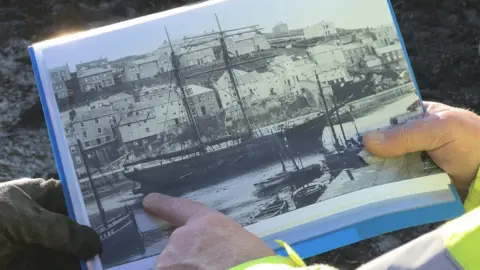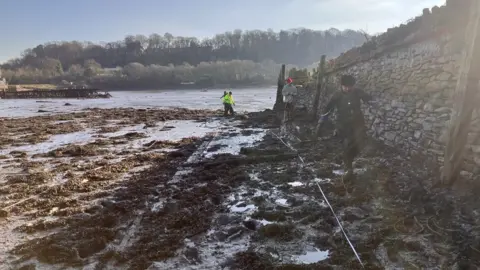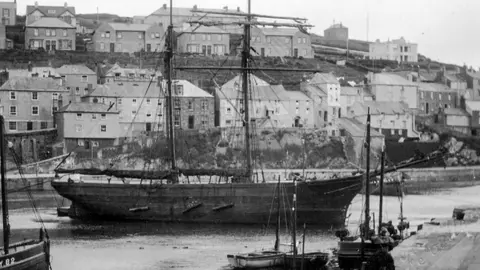True identity of rotting ship hulk in Plymouth discovered
 BBC
BBCA team of maritime archaeologists has discovered the true identity of a large wooden ship hulk buried in Hooe Lake, on the outskirts of Plymouth.
The remains of the vessel lie buried alongside a stone jetty on the north side of the lake.
The hulk has now been identified by The Ships Project as the John Sims, a Westcountry schooner.
Until the recent discovery, it was thought to have been a Dutch barge called the Two Brothers.
The Ships Project is a volunteer non-profit organisation that undertakes research and exploration of maritime historical sites and events, both on land and underwater.
Hooe Lake is known as a "ships' graveyard" due to the 36 known ship hulks buried there.

The Ships Project said it was thought Hooe Lake had been a place where boats had been abandoned for centuries.
The lake is shallow and tidal, so boats can be abandoned at high tide, yet still accessed when the tide recedes.
While writing up archaeological investigations, the team discovered a letter between local historians John Cotton and Martin Langley when going through John Cotton's archive.
The letter - kept in John Cotton's maritime archives - identified this ship as the schooner John Sims.
Mallory Haas, a maritime archaeologist and director of the project, said there was not a lot of information available on the hulk to begin with.

However, when an archaeological investigation of the hull was undertaken, the team discovered it was not constructed like a barge, but more like a Westcountry ship, or schooner.
"We now have all of this fabulous history and a picture of what she looked like when she was afloat, so it all kind of comes together, and we're putting together a book on this and now we have the name of a really interesting wreck," Ms Haas said.
She added: "From what we can understand, this has been a place for abandoning ships since the Roman times, so there's quite a lot of mud around.
"But underneath the mud are probably even older hulks and shipwrecks - we just can't see them.
"It's kind of important to understand what this place is, even though the ones that we can see, you know, like some of these are from the 1890s, 1870s, 1920s, and even from the 1960s.
"But, collectively, it tells a story of Plymouth and its maritime heritage."
 The National Maritime Museum/The SHIPS Project
The National Maritime Museum/The SHIPS ProjectThe Ships Project's director, Peter Holt, said, according to historic records, the John Sims sailed until 1935, when it was converted to a timber lighter for use in the Oreston timber yard at the end of Hooe Lake.
He said records showed the ship was built in Falmouth by HS Trethowan for the Sims family in 1873 and registered in Plymouth at 98 tons.
In 1893, the ship was sold to Thomas Stevens of Bursledon, near Southampton, then, in 1900, it was sold to Richard Foster of Gloucester and it was reregistered at that port.
By March 1917, Albert Westcott purchased the vessel, moved it to Plymouth and appointed Bill Stiles as its master.

The registry closed on the ship in 1935, when it was converted to be a timber lighter in Plymouth.
At some point later on, the schooner was abandoned on the east side of the stone jetty in Hooe Lake - where it remains.
Mr Holt said: "Plymouth's got the most amazing maritime history, which stretches back to 12,000BC onwards, and, every time we look at something, we find something new.
"The hulks in Hooe Lake tell us lots about trading and what was happening in Plymouth back in the 1800s, but also they provide examples of ships which kind of no longer exist.
"Some of the ones we found in the lake, some of the ones we've identified, are the last surviving examples of this particular type - and, by investigating them, by archaeologically excavating them, we can learn how they were built."

Follow BBC News South West on Twitter, Facebook and Instagram. Send your story ideas to [email protected].
